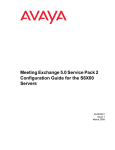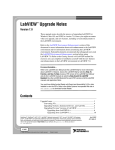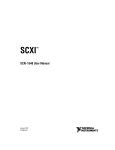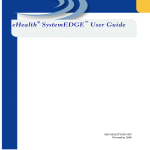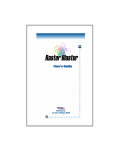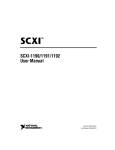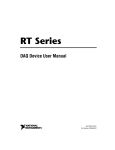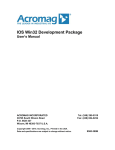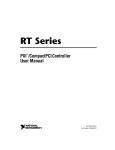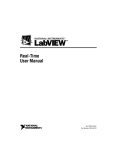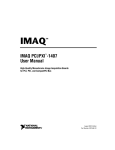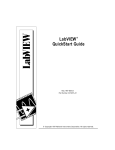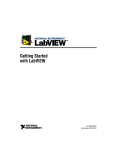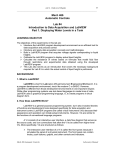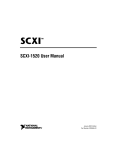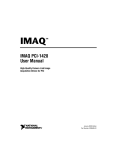Download LabVIEW Report Generation Toolkit for Microsoft Office User Manual
Transcript
Report Generation Toolkit for Microsoft Office User Manual LabVIEW Report Generation Toolkit User Manual April 2001 Edition Part Number 322880A-01 Support Worldwide Technical Support and Product Information ni.com National Instruments Corporate Headquarters 11500 North Mopac Expressway Austin, Texas 78759-3504 USA Tel: 512 794 0100 Worldwide Offices Australia 03 9879 5166, Austria 0662 45 79 90 0, Belgium 02 757 00 20, Brazil 011 284 5011, Canada (Calgary) 403 274 9391, Canada (Ottawa) 613 233 5949, Canada (Québec) 514 694 8521, Canada (Toronto) 905 785 0085, China (Shanghai) 021 6555 7838, China (ShenZhen) 0755 3904939, Denmark 45 76 26 00, Finland 09 725 725 11, France 01 48 14 24 24, Germany 089 741 31 30, Greece 30 1 42 96 427, Hong Kong 2645 3186, India 91805275406, Israel 03 6120092, Italy 02 413091, Japan 03 5472 2970, Korea 02 596 7456, Malaysia 603 9596711, Mexico 5 280 7625, Netherlands 0348 433466, New Zealand 09 914 0488, Norway 32 27 73 00, Poland 0 22 528 94 06, Portugal 351 1 726 9011, Singapore 2265886, Spain 91 640 0085, Sweden 08 587 895 00, Switzerland 056 200 51 51, Taiwan 02 2528 7227, United Kingdom 01635 523545 For further support information, see the Technical Support Resources appendix. To comment on the documentation, send e-mail to [email protected] Copyright © 2001 National Instruments Corporation. All rights reserved. Important Information Warranty The media on which you receive National Instruments software are warranted not to fail to execute programming instructions, due to defects in materials and workmanship, for a period of 90 days from date of shipment, as evidenced by receipts or other documentation. National Instruments will, at its option, repair or replace software media that do not execute programming instructions if National Instruments receives notice of such defects during the warranty period. National Instruments does not warrant that the operation of the software shall be uninterrupted or error free. A Return Material Authorization (RMA) number must be obtained from the factory and clearly marked on the outside of the package before any equipment will be accepted for warranty work. National Instruments will pay the shipping costs of returning to the owner parts which are covered by warranty. National Instruments believes that the information in this document is accurate. The document has been carefully reviewed for technical accuracy. In the event that technical or typographical errors exist, National Instruments reserves the right to make changes to subsequent editions of this document without prior notice to holders of this edition. The reader should consult National Instruments if errors are suspected. In no event shall National Instruments be liable for any damages arising out of or related to this document or the information contained in it. EXCEPT AS SPECIFIED HEREIN, NATIONAL INSTRUMENTS MAKES NO WARRANTIES, EXPRESS OR IMPLIED, AND SPECIFICALLY DISCLAIMS ANY WARRANTY OF MERCHANTABILITY OR FITNESS FOR A PARTICULAR PURPOSE. CUSTOMER’S RIGHT TO RECOVER DAMAGES CAUSED BY FAULT OR NEGLIGENCE ON THE PART OF NATIONAL INSTRUMENTS SHALL BE LIMITED TO THE AMOUNT THERETOFORE PAID BY THE CUSTOMER. NATIONAL INSTRUMENTS WILL NOT BE LIABLE FOR DAMAGES RESULTING FROM LOSS OF DATA, PROFITS, USE OF PRODUCTS, OR INCIDENTAL OR CONSEQUENTIAL DAMAGES, EVEN IF ADVISED OF THE POSSIBILITY THEREOF. This limitation of the liability of National Instruments will apply regardless of the form of action, whether in contract or tort, including negligence. Any action against National Instruments must be brought within one year after the cause of action accrues. National Instruments shall not be liable for any delay in performance due to causes beyond its reasonable control. The warranty provided herein does not cover damages, defects, malfunctions, or service failures caused by owner’s failure to follow the National Instruments installation, operation, or maintenance instructions; owner’s modification of the product; owner’s abuse, misuse, or negligent acts; and power failure or surges, fire, flood, accident, actions of third parties, or other events outside reasonable control. Copyright Under the copyright laws, this publication may not be reproduced or transmitted in any form, electronic or mechanical, including photocopying, recording, storing in an information retrieval system, or translating, in whole or in part, without the prior written consent of National Instruments Corporation. Trademarks LabVIEW™, National Instruments™, and ni.com™ are trademarks of National Instruments Corporation. Product and company names mentioned herein are trademarks or trade names of their respective companies. Disclaimer Microsoft® is a registered trademark of Microsoft Corporation in the United States and other countries. Use of Microsoft Corporation’s trademarks does not constitute sponsorship, affiliation, or endorsement of National Instruments by Microsoft Corporation. WARNING REGARDING USE OF NATIONAL INSTRUMENTS PRODUCTS (1) NATIONAL INSTRUMENTS PRODUCTS ARE NOT DESIGNED WITH COMPONENTS AND TESTING FOR A LEVEL OF RELIABILITY SUITABLE FOR USE IN OR IN CONNECTION WITH SURGICAL IMPLANTS OR AS CRITICAL COMPONENTS IN ANY LIFE SUPPORT SYSTEMS WHOSE FAILURE TO PERFORM CAN REASONABLY BE EXPECTED TO CAUSE SIGNIFICANT INJURY TO A HUMAN. (2) IN ANY APPLICATION, INCLUDING THE ABOVE, RELIABILITY OF OPERATION OF THE SOFTWARE PRODUCTS CAN BE IMPAIRED BY ADVERSE FACTORS, INCLUDING BUT NOT LIMITED TO FLUCTUATIONS IN ELECTRICAL POWER SUPPLY, COMPUTER HARDWARE MALFUNCTIONS, COMPUTER OPERATING SYSTEM SOFTWARE FITNESS, FITNESS OF COMPILERS AND DEVELOPMENT SOFTWARE USED TO DEVELOP AN APPLICATION, INSTALLATION ERRORS, SOFTWARE AND HARDWARE COMPATIBILITY PROBLEMS, MALFUNCTIONS OR FAILURES OF ELECTRONIC MONITORING OR CONTROL DEVICES, TRANSIENT FAILURES OF ELECTRONIC SYSTEMS (HARDWARE AND/OR SOFTWARE), UNANTICIPATED USES OR MISUSES, OR ERRORS ON THE PART OF THE USER OR APPLICATIONS DESIGNER (ADVERSE FACTORS SUCH AS THESE ARE HEREAFTER COLLECTIVELY TERMED “SYSTEM FAILURES”). ANY APPLICATION WHERE A SYSTEM FAILURE WOULD CREATE A RISK OF HARM TO PROPERTY OR PERSONS (INCLUDING THE RISK OF BODILY INJURY AND DEATH) SHOULD NOT BE RELIANT SOLELY UPON ONE FORM OF ELECTRONIC SYSTEM DUE TO THE RISK OF SYSTEM FAILURE. TO AVOID DAMAGE, INJURY, OR DEATH, THE USER OR APPLICATION DESIGNER MUST TAKE REASONABLY PRUDENT STEPS TO PROTECT AGAINST SYSTEM FAILURES, INCLUDING BUT NOT LIMITED TO BACK-UP OR SHUT DOWN MECHANISMS. BECAUSE EACH END-USER SYSTEM IS CUSTOMIZED AND DIFFERS FROM NATIONAL INSTRUMENTS' TESTING PLATFORMS AND BECAUSE A USER OR APPLICATION DESIGNER MAY USE NATIONAL INSTRUMENTS PRODUCTS IN COMBINATION WITH OTHER PRODUCTS IN A MANNER NOT EVALUATED OR CONTEMPLATED BY NATIONAL INSTRUMENTS, THE USER OR APPLICATION DESIGNER IS ULTIMATELY RESPONSIBLE FOR VERIFYING AND VALIDATING THE SUITABILITY OF NATIONAL INSTRUMENTS PRODUCTS WHENEVER NATIONAL INSTRUMENTS PRODUCTS ARE INCORPORATED IN A SYSTEM OR APPLICATION, INCLUDING, WITHOUT LIMITATION, THE APPROPRIATE DESIGN, PROCESS AND SAFETY LEVEL OF SUCH SYSTEM OR APPLICATION. Contents About This Manual Conventions ...................................................................................................................vii Related Documentation..................................................................................................vii Chapter 1 Overview of the Report Generation Toolkit for Microsoft Office Functions Overview .......................................................................................................1-1 Chapter 2 Creating Reports with Microsoft Word and Excel Creating New Reports....................................................................................................2-1 Inserting and Retrieving Data ........................................................................................2-2 Inserting Data into Word Documents..............................................................2-2 Inserting Text ....................................................................................2-2 Inserting Data into Excel Worksheets .............................................................2-3 Working with Tables in Word .......................................................................................2-3 Working with Images.....................................................................................................2-5 Inserting and Formatting Images in Word.......................................................2-6 Inserting and Formatting Images in Excel.......................................................2-6 Formatting Reports in Word and Excel .........................................................................2-7 Formatting Word-based Reports .....................................................................2-8 Formatting Excel-based Reports .....................................................................2-9 Using Advanced VIs in Reports ....................................................................................2-10 Word Advanced VIs ........................................................................................2-10 Visual Basic Macros .........................................................................2-10 Excel Advanced VIs ........................................................................................2-11 Visual Basic Macros .........................................................................2-11 Chapter 3 Creating Reports from Existing Templates Using Bookmarks in Word ............................................................................................3-1 Using Named Ranges in Excel ......................................................................................3-3 © National Instruments Corporation v LabVIEW Report Generation Toolkit User Manual Contents Chapter 4 Working with Graphs Inserting a New Graph................................................................................................... 4-1 Updating Data in an Existing Graph ............................................................................. 4-3 Formatting Graphs......................................................................................................... 4-3 Chapter 5 Executing VBA (Visual Basic) Macros from LabVIEW Chapter 6 Customizing the Report Generation Toolkit Working with ActiveX Automation .............................................................................. 6-1 VI Architecture.............................................................................................................. 6-2 Developing Your Own VIs............................................................................................ 6-3 Appendix A Technical Support Resources Glossary Index LabVIEW Report Generation Toolkit User Manual vi ni.com About This Manual This manual provides an overview of the LabVIEW Report Generation Toolkit for Microsoft Office. It contains information about generating reports in Microsoft Word (hereafter known as Word) and Microsoft Excel (hereafter known as Excel) formats from LabVIEW. You do not have to be proficient in Word or Excel to use this toolkit. Conventions The following conventions appear in this manual: » The » symbol leads you through nested menu items and dialog box options to a final action. The sequence File»Page Setup»Options directs you to pull down the File menu, select the Page Setup item, and select Options from the last dialog box. This icon denotes a note, which alerts you to important information. bold Bold text denotes items that you must select or click in the software, such as menu items and dialog box options. Bold text also denotes parameter names, controls and buttons on the front panel, dialog boxes, sections of dialog boxes, menu names, and palette names. italic Italic text denotes variables, emphasis, a cross reference, or an introduction to a key concept. This font also denotes text that is a placeholder for a word or value that you must supply. monospace Text in this font denotes text or characters that you should enter from the keyboard, sections of code, programming examples, and syntax examples. This font is also used for the proper names of disk drives, paths, directories, programs, subprograms, subroutines, device names, functions, operations, variables, filenames and extensions, and code excerpts. Related Documentation The following documents contain information that you might find helpful as you read this manual: • LabVIEW Report Generation Toolkit for Microsoft Office Help, available by selecting Help»Report Generation Toolkit • LabVIEW User Manual © National Instruments Corporation vii LabVIEW Report Generation Toolkit User Manual About This Manual • LabVIEW Help, available by selecting Help»Contents and Index • Microsoft Visual Basic Help, available on any version of the Microsoft Office CD LabVIEW Report Generation Toolkit User Manual viii ni.com 1 Overview of the Report Generation Toolkit for Microsoft Office Reports are an essential part of a professional application. They must contain all the information that the user wants. In addition, reports must look professional and be carefully formatted. Microsoft Word (hereafter known as Word) and Microsoft Excel (hereafter known as Excel) are powerful report writers. Most users already know how to work with these tools. The applications’ complete ActiveX interface combined with LabVIEW ActiveX client capabilities make them appropriate options for adding report generation functionalities to LabVIEW applications. The complexity of the ActiveX interface, however, makes the development of custom applications difficult. The Report Generation Toolkit isolates the user from the object model by providing a set of flexible and easy-to-use VIs. The integration of the Word and Excel report formats into the LabVIEW Report Generation VIs makes report generation even easier. Functions Overview The Report Generation Toolkit is integrated into the Functions»Report Generation palette that is part of LabVIEW. The toolkit modifies the Report Generation VIs to support Word and Excel formats as well as the standard and HTML report formats. The toolkit also includes two new subpalettes on the Report Generation palette that give the user access to lower-level Word- and Excel-specific VIs. The toolkit contains the following three categories of VIs: • © National Instruments Corporation High-level report generation VIs—These are similar to the Report Generation VIs shipped with LabVIEW. The only difference is that they support two additional report types, Word and Excel. 1-1 LabVIEW Report Generation Toolkit User Manual Chapter 1 Overview of the Report Generation Toolkit for Microsoft Office • • Word-specific VIs—The Functions»Report Generation»Word Specific VIs palette contains four high-level VIs and four subpalettes. The high-level VIs perform basic operations. VIs in the subpalettes perform the following advanced tasks: – General subpalette—document management, search and replace, page numbering – Tables subpalette—editing and formatting Word tables – Graphs and Pictures subpalette—editing and formatting pictures and Microsoft graphs – Advanced subpalette—formatting and macro functions Excel-specific VIs—The Functions»Report Generation»Excel Specific VIs palette contains four high-level VIs and four subpalettes. The high-level VIs perform basic operations. VIs in the subpalettes perform the following advanced tasks: – General subpalette—document management, search and replace, data retrieval – Format subpalette—spreadsheet and cell formatting – Graphs and Pictures subpalette—editing and formatting of pictures and Microsoft graphs – Advanced subpalette—macro functions and miscellaneous operations LabVIEW Report Generation Toolkit User Manual 1-2 ni.com 2 Creating Reports with Microsoft Word and Excel The Report Generation Toolkit includes VIs that work directly with Microsoft Word (hereafter known as Word) and Microsoft Excel (hereafter known as Excel). The VIs appear on the Functions»Report Generation» Word Specific VIs and the Functions»Report Generation» Excel Specific VIs palettes.You can use the application-specific VIs to create and edit Word documents and Excel worksheets, and to format text, tables, and pictures into Word- and Excel-based reports. Creating New Reports You can use the New Report VI located on the Functions» Report Generation palette to create a Word- or Excel-based report. Complete the following steps to generate a new report: 1. Place the New Report VI on the block diagram. 2. Set the report type parameter either to Word or Excel. 3. Set the window state parameter to minimized. This will accelerate the report generation process. 4. When you run the New Report VI, it automatically creates a Word document or Excel spreadsheet. 5. You can edit, save, and print the new report with the high-level report generation VIs on the Functions»Report Generation palette and with the application-specific VIs. For Word documents, use the Word-specific VIs located on the Functions» Report Generation»Word Specific VIs palette. For Excel worksheets, use the Excel-specific VIs located on the Functions»Report Generation»Excel Specific VIs palette. 6. Use the Word Bring to Front VI or the Excel Bring to Front VI to make the report visible. Report Generation Toolkit VIs can handle several Word documents at the same time, or several Excel worksheets in the same workbook. © National Instruments Corporation 2-1 LabVIEW Report Generation Toolkit User Manual Chapter 2 Creating Reports with Microsoft Word and Excel The Word Add Document VI allows you to add new or existing documents to the documents collection, and the Excel Add Worksheet VI allows you to add new or existing worksheets to the worksheets collection. The Word Get Document VI allows you to switch from one document to the other, which you can use to edit a report consisting of several documents. The Excel Get Worksheet VI allows you to switch from one worksheet to the other within the same workbook, which you can use to edit a report consisting of several worksheets. By default, Report Generation Toolkit VIs used with Excel apply to the first worksheet of a new workbook or to the worksheet that was active when you last saved the workbook. Inserting and Retrieving Data The Report Generation Toolkit VIs allow you to insert new data, such as text, tables, pictures, and graphs, into Word documents and Excel worksheets. Inserting Data into Word Documents You can use both high-level report generation VIs located on the Functions»Report Generation palette and Word-specific VIs located on the Functions»Report Generation»Word Specific VIs palette to insert text, tables, pictures from files, graphs, and objects into a Word document. By default, Report Generation VIs perform the insertion at the end of a document. You also can insert data into bookmarks in a Word template. Refer to Chapter 3, Creating Reports from Existing Templates, for more information about templates. Inserting Text You can use the Append Report Text VI located on the Functions»Report Generation palette to insert text at the end of the report. You also can use the Append Report Text VI to insert text into an existing template by specifying a bookmark in the MS Office parameters cluster. Refer to Chapter 3, Creating Reports from Existing Templates, for more information about bookmarks. The Word Easy Title and Word Easy Text VIs located on the Functions» Report Generation»Word Specific VIs palette also perform text insertion tasks. The Word Easy Text VI does not support bookmarks. Use the LabVIEW Report Generation Toolkit User Manual 2-2 ni.com Chapter 2 Creating Reports with Microsoft Word and Excel Word Easy Text VI to access formatting attributes such as fonts, background color, text alignment, and line style. Inserting Data into Excel Worksheets You can use high-level report generation VIs such as the Append Text to Report VI or the Append Table to Report VI located on the Functions» Report Generation palette, to insert strings, numbers, images, and arrays of numbers or strings into an active Excel worksheet. The VIs that can perform insertion tasks include a parameter called MS Office parameters that lets you specify the row and column indexes or the name of the cell or range where the insertion takes place. The Excel Get Data VI located on the Functions»Report Generation» Excel Specific VIs palette can retrieve data from an Excel worksheet. The Excel Get Data VI retrieves scalars or arrays of strings or numbers. The data type parameter specifies the type of data that you expect the VI to return. The Excel Get Data VI returns the contents of an entire worksheet if you do not wire the start and end clusters, the contents of a single cell if you wire only the start cluster, or the contents of a range of cells if you wire both the start and end clusters. To return an entire row, set the column element of the start cluster to –1. To return an entire column, set the row element of the start cluster to –1. The Excel Get Data VI is polymorphic. To ensure that the VI does not return any errors, the data type connected to the VI must be compatible with the content of the worksheet. For example, the Excel Get Data VI returns an error if you ask for a array of numbers and the worksheet contains strings. Refer to Appendix B, Polymorphic Functions, of the LabVIEW User Manual for more information about polymorphic VIs. Note Working with Tables in Word The Report Generation Toolkit VIs are capable of inserting, formatting, and editing tables in Word documents. All the tables included in a single Word document represent the document table collection. The Append Table to Report VI located on the Functions»Report Generation palette and the Word Easy Table VI located on the Functions»Report Generation»Word Specific VIs palette both can insert tables into a document. Use the Word-specific VIs located on the Functions»Report Generation»Word Specific VIs»Tables palette to edit or format any members of the table collection. By default, Table VIs apply to the last © National Instruments Corporation 2-3 LabVIEW Report Generation Toolkit User Manual Chapter 2 Creating Reports with Microsoft Word and Excel member of the table collection. However, you can apply a Table VI to any member of the collection by specifying a table in the table index parameter. Note Word tables support a maximum of 63 columns. The Word Edit Cell VI can write new values into an existing table. Because this VI is polymorphic, you can insert scalars or arrays of strings or numbers. Refer to Appendix B, Polymorphic Functions, of the LabVIEW User Manual for more information about polymorphic VIs. If you specify a scalar value, the Word Edit Cell VI inserts the value into a cell set by the row and column elements of the start cluster. If the value that you specify is an array, the VI inserts the value starting from a cell set by the start cluster. You also can use the Word Edit Cell VI to insert an image into a cell. Set the polymorphic VI to accept a file path in the value parameter instead of a scalar or array. Use the Word Format Cell VI, Word Format Table VI, and Word Table Borders and Shading VI to set format attributes such as font, alignment, and shading for existing tables. These Table VIs can format individual cells, rows, columns, or entire tables, depending on the input parameter configuration. Refer to the LabVIEW Report Generation Toolkit for Microsoft Office Help for more information about these VIs. When using Table VIs, the following guidelines apply: • If neither start nor end are wired, the VI formats the entire table. • If start is wired but end is unwired, the VI formats the unique cell, row, or column specified by start. If neither row nor column are equal to –1, the VI formats the corresponding cell. If row is equal to –1, the VI formats the entire column. If column is equal to –1, the VI formats the entire row. • If both start and end are wired, the VI formats the range of cells between start and end. Use the Word Set Table Dimension VI to set the dimensions of the document tables. You can specify the row height and the column width individually either in inches or centimeters. Use the Word Merge Cells VI and the Word Insert Row-Column-Cell VI to merge table cells or to insert rows, columns, or cells into an existing table. LabVIEW Report Generation Toolkit User Manual 2-4 ni.com Chapter 2 Creating Reports with Microsoft Word and Excel The VI in the following illustration creates a new Word document, inserts a table of numbers, and sets the table alignment to left. The VI in the following illustration creates a new document, inserts a table of numbers, and sets the cell font style to bold if the value is greater than 0.5. Working with Images The Report Generation Toolkit includes VIs that can insert, format, and edit images and graphs within Word and Excel reports. For Word-based reports, use the VIs located on the Functions»Report Generation»Word Specific VIs»Graphs and Pictures palette. For Excel-based reports, use the VIs located on the Functions»Report Generation»Excel Specific VIs»Graphs and Pictures palette. Refer to Chapter 4, Working with Graphs, for more information about how to use graphs in Word and Excel reports. © National Instruments Corporation 2-5 LabVIEW Report Generation Toolkit User Manual Chapter 2 Creating Reports with Microsoft Word and Excel Inserting and Formatting Images in Word You can use the Report Generation VIs located on the Functions»Report Generation palette to insert images into a Word document. The Append Image to Report VI, the Append Front Panel Image to Report VI, and the Append Control Image to Report VI can perform image insertion tasks. All images included in a document are part of the document Inlineshapes collection. The Inlineshapes collection also contains graphs, OLE objects, and lines. By default, the Append Image to Report, Append Front Panel Image to Report, and Append Control Image to Report VIs insert images at the end of a document. You also can insert images in a template bookmark. Refer to Chapter 3, Creating Reports from Existing Templates, for more information about templates and bookmarks. You can use the Word-specific Graph and Picture VIs located on the Functions»Report Generation»Word Specific VIs»Graphs and Pictures palette to edit images and graphs in a Word document. The Word Format Picture VI can modify the size, color, and scale of all images in the Inlineshapes collection. By default, the Word Format Picture VI applies to the last member of the Inlineshapes collection. You can apply the VI to any member of the collection, however, by specifying an image with the picture index parameter. You can select either the metric (centimeters) or English (inches) measurement system for the size parameters. The VI in the following illustration creates a new document, inserts a picture from a file, and uses the Word Format Picture VI to change the picture color to black and white. Inserting and Formatting Images in Excel You can use the Append Image to Report VI, the Append Front Panel Image to Report VI, and the Append Control Image to Report VI located on the Functions»Report Generation palette to insert images into an Excel worksheet. Use the MS Office parameters cluster to select the cell from which you want to insert the picture. LabVIEW Report Generation Toolkit User Manual 2-6 ni.com Chapter 2 Creating Reports with Microsoft Word and Excel All the images added to a worksheet are part of the worksheet Shapes collection. The Shapes collection also contains graphs and OLE objects. You also can insert images starting from a named range. Refer to Chapter 3, Creating Reports from Existing Templates, for more information about named ranges. The Excel Format Picture VI located on the Functions»Report Generation»Excel Specific VIs»Graphs and Pictures palette can modify the size, color, or scale of images in the Shapes collection. By default, the Excel Format Picture VI applies to the last member of the Shapes collection. You can apply the VI to any member of the collection, however, by specifying an image with the picture index parameter. You can select either the metric (centimeters) or English (inches) measurement system for the size parameters. The Shapes collection is relative to worksheets, not to workbooks. When you create or activate a worksheet, subsequent Graph and Picture VIs apply to the Shapes collection in the new worksheet. The VI in the following illustration creates an Excel workbook, inserts a picture from a file into the top left corner of the first spreadsheet, and sets the scale of the picture to 0.5. Formatting Reports in Word and Excel You can use both Word-specific and Excel-specific VIs to format reports, including font, alignment, and shading attributes. For a Word-based report, use the VIs related to formatting located on the Functions»Report Generation»Word Specific VIs»Advanced palette. For an Excel-based report, use the Excel Format VIs located on the Functions»Report Generation»Excel Specific VIs»Format palette. © National Instruments Corporation 2-7 LabVIEW Report Generation Toolkit User Manual Chapter 2 Creating Reports with Microsoft Word and Excel Formatting Word-based Reports The Word-specific Advanced VIs located on the Functions»Report Generation»Word Specific VIs»Advanced palette provide most of the Word formatting functionalities available in the Report Generation Toolkit. The Word Format Text VI can set the font attributes of sections of a document. The Word Format Borders and Word Format Paragraph VIs can set the shading, border, and paragraph attributes. You can apply the Advanced VIs related to formatting either to an entire document or to a specific section of the document. To format an entire document, use the default values for the start and end input of the formatting VIs. To format a custom range in a document, use the start and end inputs to specify the positions of the first and last characters of the range. Send the start out and end out output values from the report generation VIs that are related to insertion to the start and end input values of the formatting VIs. The VI in the following illustration creates a new Word document, inserts text and a picture into the document, and sets the alignment of the text and picture to centered. The start index of the Append Image to Report and Word Format Paragraph VIs is retrieved from the start out output of Append Report Text VI. The end index of the Word Format Paragraph VI is retrieved from the end out output of the Append Image to Report VI. Paragraph, shading, and borders parameters are clusters that contain a large number of elements, and therefore can use a large amount of block diagram space. To conserve space on the block diagram, you can use the Indent and Spacing Constant and the Borders and Shading Constant located on the Functions»Report Generation»Word Specific VIs»Advanced»Constants palette with the Bundle by Name function located on the Functions»Cluster palette as shown in the previous illustration. Note LabVIEW Report Generation Toolkit User Manual 2-8 ni.com Chapter 2 Creating Reports with Microsoft Word and Excel Formatting Excel-based Reports You can use the Excel Set Cell Font VI, the Excel Set Cell Alignment VI, and the Excel Set Cell Color and Border VI located on the Functions» Report Generation»Excel Specific VIs»Format palette to set formatting attributes in a worksheet. These VIs can format individual cells or an entire worksheet, depending on how you set the start and end parameters. The following guidelines apply to Format VIs: • If neither start nor end are wired, the VI formats the entire used section of the current worksheet. • If start is wired but end is not wired, the VI formats the unique cell, row, or column specified by start. If neither row nor column are equal to –1, the VI formats the corresponding cell. If row is equal to –1, the VI formats the entire column. If column is equal to –1, the VI formats the entire row. • If both start and end are wired, the VI formats the range of cells between start and end. The Excel Set Format VI can set the number format of cells in a worksheet. Number formats customize the way Excel displays numbers, dates, times, and strings. Refer to your Excel documentation for more information about Excel format types. The VI in the following illustration creates a new workbook, inserts an array of numbers with header strings, and sets the background color of the header to light green. © National Instruments Corporation 2-9 LabVIEW Report Generation Toolkit User Manual Chapter 2 Creating Reports with Microsoft Word and Excel The VI in the following illustration creates a new workbook, inserts an array of numbers, and formats the cells so that numbers lower than 0.5 display in blue and numbers greater than 0.5 display in red. Using Advanced VIs in Reports The Report Generation Toolkit includes VIs that you can use for advanced tasks in Word documents and Excel spreadsheets. For Word-based reports, use the VIs located on the Functions»Report Generation»Word Specific VIs»Advanced palette. For Excel-based reports, use the VIs located on the Functions»Report Generation»Excel Specific VIs»Advanced palette. Word Advanced VIs The Functions»Report Generation»Word Specific VIs»Advanced palette contains a set of VIs that access various advanced Word features. You can use the Word Insert Object VI to exchange data between Word and Excel. You can embed an Excel table into a Word document or insert any file into a Word document. If the file does not correspond to a Microsoft Office object, the Word Insert Object VI does not embed the object but instead creates a link to the file containing the object. The Word Send Document VI can email Word reports automatically to a list of recipients. Visual Basic Macros The Functions»Report Generation»Word Specific VIs»Advanced» Macros palette contains VIs that can run Microsoft Visual Basic macros from LabVIEW. Refer to Chapter 5, Executing VBA (Visual Basic) Macros from LabVIEW, for more information about macros. LabVIEW Report Generation Toolkit User Manual 2-10 ni.com Chapter 2 Creating Reports with Microsoft Word and Excel Excel Advanced VIs The Functions»Report Generation»Excel Specific VIs»Advanced palette contains a set of VIs that can access various advanced Excel features. You can use the Excel Rename Worksheet VI to give worksheets names that you choose. You can use the Excel Insert Object VI to exchange data between Word and Excel. You can embed a Word document into an Excel worksheet or insert any file into an Excel worksheet. If the file does not correspond to a Microsoft Office object, the Excel Insert Object VI does not embed the object but instead creates a link to the file containing the object. The Excel Send Document VI can email Excel reports automatically to a list of recipients. You can use the Excel Sort Data VI and the Excel Insert Formula VI to analyze data written in a worksheet. The Excel Sort Data VI sorts a particular range of cells in ascending or descending order, either horizontally or vertically. The Excel Insert Formula VI inserts formulas into the worksheet by specifying a cell position and the formula string. Refer to your Excel documentation for more information about formulas. Visual Basic Macros The Functions»Report Generation»Excel Specific VIs»Advanced» Macros palette contains VIs that can run Visual Basic macros from LabVIEW. Refer to Chapter 5, Executing VBA (Visual Basic) Macros from LabVIEW, for more information about macros. © National Instruments Corporation 2-11 LabVIEW Report Generation Toolkit User Manual Creating Reports from Existing Templates 3 Generating complex and highly formatted reports is a time-consuming process. The best way to increase productivity is to create a report template containing components that are common to all reports and placeholders for the data. After you save this template, you can generate reports by opening the report template, inserting data into the placeholders, and displaying, printing, or saving the resulting report. Both Microsoft Word (hereafter known as Word) and Microsoft Excel (hereafter known as Excel) provide ways to insert placeholders into documents and worksheets and to save reusable templates. In Word, the easiest way to define placeholders is to use bookmarks. In Excel, the easiest way to define placeholders is to use named ranges. Using Bookmarks in Word You can use bookmarks to insert text, numbers, tables, or pictures into a template. Complete the following steps to define a bookmark in your report template. 1. In Word, open your report template. Place the cursor in the location where you want the new bookmark to be. 2. Select Insert»Bookmark. © National Instruments Corporation 3-1 LabVIEW Report Generation Toolkit User Manual Chapter 3 Creating Reports from Existing Templates 3. Type the bookmark name you want to use and click the Add button as shown in the following dialog box. Use meaningful names to remember the significance of the bookmarks in the template. When editing your report template, you can display bookmarks by selecting Tools»Options in Word to open the Options dialog box. Click the View tab and select Bookmarks. The VIs that can perform insertion tasks all include the MS Office parameters cluster, which lets you specify the bookmark from which the insertion is performed. If you do not specify a bookmark, the insertion is automatically performed at the end of the document. You also can send data to a preformatted table in your template with the Word Edit Cell VI. This VI can update either individual cells or a complete range. Use the start parameter to specify the location of the cell or range to update. Use the table index parameter to specify the location of the table to update. A value of n in the table index parameter represents the (n + 1)th table of the current document. The default value of –1 represents the last table of the document. Templates can include empty graphs you can update with the Word Update Graph VI. Refer to Chapter 4, Working with Graphs, for more information about graphs. LabVIEW Report Generation Toolkit User Manual 3-2 ni.com Chapter 3 Creating Reports from Existing Templates The VI in the following illustration opens a template, updates the date and time bookmarks with new data, sends values to the last table of the template, and prints the resulting report. Using Named Ranges in Excel You can define a named range in Excel to insert text, numbers, tables, or pictures into a template. Complete the following steps to define a named range in your report template. 1. In Excel, open your report template. Select the cell or the range of cells that you want to include in the named range. 2. Select Insert»Name»Define. 3. Type the name you want to use for the named range and click the Add button as shown in the following dialog box. Use meaningful names to remember the significance of the named ranges in the template. © National Instruments Corporation 3-3 LabVIEW Report Generation Toolkit User Manual Chapter 3 Creating Reports from Existing Templates The VIs that can perform insertion tasks all include the MS Office parameters cluster, which lets you specify the named range from which the insertion is performed. If you do not specify a named range, the insertion is performed from the cell defined by the position cluster. The VI in the following illustration opens an existing report template, updates the date and time ranges with new values, updates a table in the template with new values, and saves the report. LabVIEW Report Generation Toolkit User Manual 3-4 ni.com Working with Graphs 4 This chapter explains how to use the Report Generation Toolkit to insert, format, and update graphs from the Microsoft Graph application into Microsoft Word (hereafter known as Word) documents or Microsoft Excel (hereafter known as Excel) worksheets. The Graph and Picture VIs in the Report Generation Toolkit provide an interface to the Microsoft Graph application, which is part of the Microsoft Office package. You must install Microsoft Graph on your system to use these VIs. Inserting a New Graph Use the Word Insert Graph VI or the Excel Insert Graph VI to insert a new graph into the current document or worksheet. You must send data to the graph as a 2D array of numbers. You can send row and column headers, or values and categories, as 1D arrays of strings. Graphs can hold up to 4000 rows and 4000 columns, and can display up to 256 data series. When you format a graph, remember that graphs are members either of an Inlineshapes collection in a Word document or a Shapes collection in an Excel worksheet. Each graph in one of these collections accounts for one index value. If your report contains two pictures followed by one graph, the index value representing the graph is 2 and the index representing the first picture is 0. Format images and graphs immediately after inserting them into the document or worksheet to avoid confusion with the collection indexes. By default, VIs that are related to formatting apply to the last member added to the document or worksheet. © National Instruments Corporation 4-1 LabVIEW Report Generation Toolkit User Manual Chapter 4 Working with Graphs The Word Insert Graph VI and the Excel Insert Graph VI support all the graph types provided by Microsoft Graph. The following table explains the most commonly used graph types. Graph Type XY (Scatter) Description An xy (scatter) graph shows the relationship or degree of a relationship between the numbers in several graph data series, or plots two groups of numbers as one series of xy coordinates. The xy graph shows uneven intervals of data. The arrangement of the data on the worksheet is very important when creating an xy graph. Data must be arranged with the x values in one row or column, followed by one or more corresponding y values in the adjacent rows or columns. Note: Only xy graphs have the ability to scale both the x and y axes. Line Line graphs show trends or changes in data over a period of time at even intervals. Although line graphs are similar to area graphs, line graphs emphasize time flow and the rate of change rather than the amount of change or magnitude of values. Column Column graphs show variation over a period of time or illustrate comparisons between items. Stacked and 100-percent stacked column graphs show relationships to a whole. Although column graphs are similar to bar graphs, column graphs organize categories horizontally and values vertically. Bar Bar graphs show individual figures at a specific time or illustrate comparisons between items. Stacked and 100-percent stacked bar graphs show relationships to a whole. Although bar graphs are similar to column graphs, bar graphs organize categories vertically and values horizontally. This type of organization places more emphasis on comparisons and less emphasis on time. Three-dimensional Surface Three-dimensional surface graphs show a view that resembles a sheet stretched over a three-dimensional column graph. Surface graphs are useful for finding the best combinations between two sets of data. This graph can show relationships between large amounts of data that might otherwise be difficult to see. As in topographic maps, colors or patterns indicate areas that have the same value. The colors do not mark the data series. The wire frame format displays the data in black and white. The contour graph formats provide a two-dimensional view of the data from above, similar to a two-dimensional topographic map. LabVIEW Report Generation Toolkit User Manual 4-2 ni.com Chapter 4 Graph Type Working with Graphs Description Pie Pie graphs show the relationship or proportions of the parts to the whole. Pie graphs are useful for emphasizing a significant element. A pie graph always contains one data series. If you select more than one data series when you create a pie graph, only one data series displays. To display more than one data series in a round graph format, use the doughnut graph type. Area Area graphs show the relative importance of values over a period of time. Although area graphs are similar to line graphs, area graphs emphasize the amount of change or magnitude of values rather than time and the rate of change. Updating Data in an Existing Graph If you need to format your graph in a way that is not supported by the graph formatting VIs, you can insert the graph in a template, format the graph the way you want, and use the Word Update Graph VI or the Excel Update Graph VI to fill the graph with data. You can use these VIs to update numerical data, row and column headers, or values and categories. To specify the location of the graph that you want to update, transfer the graph index number from the Inlineshapes or Shapes collection to the graph index parameter. Graphs, pictures, and OLE objects are members either of an Inlineshapes collection in a Word document or a Shapes collection in an Excel worksheet. Each graph in one of these collections accounts for one index value. Note Formatting Graphs You can use the VIs located on the Graphs and Pictures palettes of both the Functions»Report Generation»Word Specific VIs and the Functions»Report Generation»Excel Specific VIs palettes to format existing graphs. The Word Format Picture VI and the Excel Format Picture VI can set graph size or change color type. Other Graph and Picture VIs can set color attributes, modify scale, and set font attributes for existing graphs. To specify the location of a graph that you want to format, transfer the graph index number from the Inlineshapes or Shapes collection to the graph index parameter. © National Instruments Corporation 4-3 LabVIEW Report Generation Toolkit User Manual Executing VBA (Visual Basic) Macros from LabVIEW 5 This chapter explains how to use the Report Generation Toolkit to execute VBA (Microsoft Visual Basic) macros from LabVIEW into Microsoft Word (hereafter known as Word) documents or Microsoft Excel (hereafter known as Excel) workbooks. For Word documents, use the VIs located on the Functions»Report Generation»Word Specific VIs» Advanced»Macros palette. For Excel workbooks, use the VIs located on the Functions»Report Generation»Word Specific VIs»Advanced» Macros palette. You can use the Word Run Macro VI and the Excel Run Macro VI to execute VBA macros from LabVIEW. The VIs can run both existing VBA macros and macros that you program to implement functionalities that the Report Generation Toolkit does not support. If the macro you want to execute requires input arguments, you can enter them into the parameters input of the VI you are using. The data type for this input is an array of variants. You must therefore convert all the input parameters passed to the macro to variants and bundle the parameters into an array. Use the To Variant function located on the Functions» Advanced»Data Manipulation»Variant palette to convert the parameters to variants. Use the Build Array function located on the Functions»Array palette to build the parameters into an array. If you need to retrieve an output value from a macro executed in LabVIEW, you can find this value in the return value parameter of the Word Run Macro VI or the Excel Run Macro VI. The output value is returned as a variant. You must convert the value to LabVIEW-compatible data before being used by LabVIEW. Use the Variant to Data function from the Functions»Communication»ActiveX palette to convert the output value. Word and Excel 2000 and Excel 97 support the ability to pass data to and from the macro. Word 97 does not offer this feature. Note © National Instruments Corporation 5-1 LabVIEW Report Generation Toolkit User Manual Chapter 5 Executing VBA (Visual Basic) Macros from LabVIEW Before executing a macro from LabVIEW, make sure that the module in which the macro is defined is present either in the VBA project associated with the document or in the template on which the document is based, for example, normal.dot. If report generation starts from a Word or Excel template, you can import the module containing the macro manually into the VBA project associated with the template. Complete the following steps to import the module manually. 1. Open the template in Word or Excel. 2. Select Tools»Macro»Visual Basic Editor. 3. In the project window of the Visual Basic editor, right-click the template and select Import File from the shortcut menu. 4. Click the name of the file in which the macro is defined. The Word Import Module VI and the Excel Import Module VI can also import modules dynamically from LabVIEW. Using these two VIs, you can import modules either from a *.bas file or from a LabVIEW string that contains the module code source. To run a macro that manipulates objects from another application, set a reference to the application type library. This allows easy access to objects that use either the Word Add Reference to VB Project VI or the Excel Add Reference to VB Project VI. Refer to the Microsoft Visual Basic Help for more information on type libraries. The VI in the following illustration opens Word, creates a new document, inserts a table into the document, adds a VBA module to the document, executes the ProcessTable macro defined in this module, removes the module from the document, and saves it. LabVIEW Report Generation Toolkit User Manual 5-2 ni.com Customizing the Report Generation Toolkit 6 This chapter explains how to develop and integrate custom tasks into the Report Generation Toolkit. You can create your own VIs with functionalities that are not available in the Report Generation Toolkit. Working with ActiveX Automation In this manual, ActiveX refers to the Microsoft ActiveX technology and OLE technology. This technology is available only on Windows. Refer to Chapter 18, ActiveX, of the LabVIEW User Manual for more information about how LabVIEW works with ActiveX. The Report Generation Toolkit has been designed around ActiveX Automation technology. This technology is based on the Microsoft Component Object Model (COM), which enables programs to interact with one another. Automation allows LabVIEW to manipulate Word and Excel objects. LabVIEW acts as an automation client that takes control of the objects exposed by Microsoft Word (hereafter known as Word) and Microsoft Excel (hereafter known as Excel), both of which are automation servers. The term object refers to any Word or Excel element that you can program, manipulate, or control. Documents, cells, tables, and images are objects. All these objects have properties and methods that you can access through LabVIEW. Properties are characteristics of an object and methods are actions that can be performed on an object. In Excel, for example, the Cell object exposes the Font property and the Select method. In Word, the Document object exposes the PageSetup property and the SaveAs method. Complete the following steps to control Word or Excel from LabVIEW using ActiveX automation. 1. © National Instruments Corporation Use the Automation Open function located on the Functions» Communication»ActiveX palette to open a reference to either the Word or Excel application. 6-1 LabVIEW Report Generation Toolkit User Manual Chapter 6 Customizing the Report Generation Toolkit 2. Use the Property and Invoke Nodes located on the Functions» Communication»ActiveX palette to access and control all the objects exposed by that application. 3. Use the Automation Close function located on the Functions» Communication»ActiveX palette to release all the objects after the application reference ends. VI Architecture The Report Generation Toolkit VIs are based on the LabVIEW Report Generation VIs. The Report Generation Toolkit extends the Report Class object to include some of the most frequently used Word and Excel objects. The New Report VI opens a reference to either Word or Excel, depending on the selected report type, and to a set of objects that are bundled into the Report Class object. Objects include documents, tables, and Inlineshapes in Word, and workbooks, worksheets, and Shapes for Excel. When you use subsequent VIs, the Report Class object can extract Word and Excel objects for modification by using LabVIEW property and invoke nodes. The VI in the following illustration obtains a reference to the Tables object in Word, and invokes the Add method to add a new table into the document. After report generation is complete, you can use the Dispose Report VI to release all objects contained in the report class parameter. LabVIEW Report Generation Toolkit User Manual 6-2 ni.com Chapter 6 Customizing the Report Generation Toolkit Developing Your Own VIs You can use the Word VI Template VI and Excel VI Template VI to develop your own report generation VIs. These template VIs consist of an empty structure that you can customize to access Word and Excel objects, set their properties, and invoke methods to implement new functionalities. Do not save your own VIs into vi.lib. LabVIEW overwrites these libraries when you upgrade. Note You also can customize tasks with the Macro VIs. Refer to Chapter 5, Executing VBA (Visual Basic) Macros from LabVIEW, for more information about Microsoft Visual Basic macros. © National Instruments Corporation 6-3 LabVIEW Report Generation Toolkit User Manual Technical Support Resources A Web Support National Instruments Web support is your first stop for help in solving installation, configuration, and application problems and questions. Online problem-solving and diagnostic resources include frequently asked questions, knowledge bases, product-specific troubleshooting wizards, manuals, drivers, software updates, and more. Web support is available through the Technical Support section of ni.com NI Developer Zone The NI Developer Zone at ni.com/zone is the essential resource for building measurement and automation systems. At the NI Developer Zone, you can easily access the latest example programs, system configurators, tutorials, technical news, as well as a community of developers ready to share their own techniques. Customer Education National Instruments provides a number of alternatives to satisfy your training needs, from self-paced tutorials, videos, and interactive CDs to instructor-led hands-on courses at locations around the world. Visit the Customer Education section of ni.com for online course schedules, syllabi, training centers, and class registration. System Integration If you have time constraints, limited in-house technical resources, or other dilemmas, you may prefer to employ consulting or system integration services. You can rely on the expertise available through our worldwide network of Alliance Program members. To find out more about our Alliance system integration solutions, visit the System Integration section of ni.com © National Instruments Corporation A-1 LabVIEW Report Generation Toolkit User Manual Appendix A Technical Support Resources Worldwide Support National Instruments has offices located around the world to help address your support needs. You can access our branch office Web sites from the Worldwide Offices section of ni.com. Branch office Web sites provide up-to-date contact information, support phone numbers, e-mail addresses, and current events. If you have searched the technical support resources on our Web site and still cannot find the answers you need, contact your local office or National Instruments corporate. Phone numbers for our worldwide offices are listed at the front of this manual. LabVIEW Report Generation Toolkit User Manual A-2 ni.com Glossary Prefix Meaning Value m- milli- 10 –3 k- kilo- 10 3 M- mega- 10 6 bookmark A placeholder in a Microsoft Word template from which you can insert text, numbers, tables, or pictures. Inlineshapes collection All the images, graphs, OLE objects, and lines in a Microsoft Word document. named range A placeholder in a Microsoft Excel template from which you can insert text, numbers, tables, or pictures. object A Microsoft Word or Excel element that you can program, manipulate, or control using ActiveX automation. Shapes collection All the images, graphs, and OLE objects in an Microsoft Excel worksheet. workbook A Microsoft Excel file that consists of multiple worksheets. worksheet A Microsoft Excel spreadsheet, part of a workbook file, in which you can format and store data. © National Instruments Corporation G-1 LabVIEW Report Generation Toolkit User Manual Index A D ActiveX Automation, 6-1 to 6-2 advanced VIs Excel advanced VIs, 2-11 Word advanced VIs, 2-10 Append Control Image to Report VI, 2-6 Append Front Panel Image to Report VI, 2-6 Append Image to Report VI, 2-6 Append Report Text VI, 2-2 Append Table to Report VI, 2-3 Append Text to Report VI, 2-3 area graphs (table), 4-3 data inserting into Word reports, 2-2 to 2-3 into worksheets, 2-3 updating in existing graph, 4-3 documentation conventions used in manual, vii related documentation, vii-viii E Excel Add Reference to VB Project VI, 5-2 Excel Add Worksheet VI, 2-2 Excel Format Picture VI, 2-7, 4-3 Excel Get Data VI, 2-3 Excel Get Worksheet VI, 2-2 Excel Import Module VI, 5-2 Excel Insert Formula VI, 2-11 Excel Insert Graph VI, 4-1 Excel Insert Object VI, 2-11 Excel Rename Worksheet VI, 2-11 Excel reports advanced VIs, 2-11 creating new reports, 2-1 to 2-2 formatting, 2-9 to 2-10 graphs, 4-1 to 4-3 inserting and formatting images, 2-6 to 2-7 inserting data into worksheets, 2-3 named ranges, 3-3 to 3-4 Visual Basic macros, 5-1 to 5-2 Excel Run Macro VI, 5-1 Excel Send Document VI, 2-11 B bar graphs (table), 4-2 bookmarks in Word, 3-1 to 3-3 Borders and Shading Constant (note), 2-8 borders and shading parameters (note), 2-8 C column graphs (table), 4-2 conventions used in manual, vii creating new reports, 2-1 to 2-2 customer education, A-1 customizing Report Generation Toolkit, 6-1 to 6-3 ActiveX Automation technology, 6-1 to 6-2 developing VIs, 6-3 VI architecture, 6-2 © National Instruments Corporation I-1 LabVIEW Report Generation Toolkit User Manual Index Excel Set Cell Alignment VI, 2-9 Excel Set Cell Color and Border VI, 2-9 Excel Set Cell Font VI, 2-9 Excel Set Format VI, 2-9 Excel Sort Data VI, 2-11 Excel VI Template VI, 6-3 Excel-specific VIs, 1-2 inserting images Excel reports, 2-6 to 2-7 Word reports, 2-6 F M formatting Excel reports, 2-9 graphs, 4-3 images Excel reports, 2-6 to 2-7 Word reports, 2-6 Word reports, 2-8 Microsoft Excel reports. See Excel reports. Microsoft Visual Basic macros. See Visual Basic macros. Microsoft Word reports. See Word reports. L line graphs (table), 4-2 N named ranges in Excel reports, 3-3 to 3-4 New Report VI, 2-1, 6-2 new reports, creating, 2-1 to 2-2 NI Developer Zone, A-1 G graphs, 4-1 to 4-3 formatting, 4-3 inserting, 4-1 to 4-3 types of graphs supported (table), 4-2 to 4-3 updating data in existing graph, 4-3 P pie graphs (table), 4-3 R H report generation. See Excel reports; Word reports. Report Generation palette, 1-1 Report Generation Toolkit customizing, 6-1 to 6-3 ActiveX Automation technology, 6-1 to 6-2 developing VIs, 6-3 VI architecture, 6-2 functions overview, 1-1 to 1-2 overview, 1-1 high-level Report Generation VIs, 1-1 I images, inserting and formatting Excel reports, 2-6 to 2-7 Word reports, 2-6 Indent and Spacing Constant (note), 2-8 inserting data Excel reports, 2-3 Word reports, 2-2 to 2-3 LabVIEW Report Generation Toolkit User Manual I-2 ni.com Index S Word Add Reference to VB Project VI, 5-2 Word Easy Text VI, 2-2 to 2-3 Word Easy Title VI, 2-2 Word Edit Cell VI, 2-4, 3-2 Word Format Borders VI, 2-8 Word Format Cell VI, 2-4 Word Format Paragraph VI, 2-8 Word Format Picture VI, 2-6, 4-3 Word Format Table VI, 2-4 Word Format Text VI, 2-8 Word Get Document VI, 2-2 Word Import Module VI, 5-2 Word Insert Graph VI, 4-1 Word Insert Object VI, 2-10 Word Insert Row-Column-Cell VI, 2-4 Word Merge Cells VI, 2-4 Word reports advanced VIs, 2-10 bookmarks, 3-1 to 3-3 creating new reports, 2-1 to 2-2 formatting, 2-8 graphs, 4-1 to 4-3 inserting and formatting images, 2-6 inserting data and text, 2-2 to 2-3 tables, 2-3 to 2-5 Visual Basic macros, 5-1 to 5-2 Word Run Macro VI, 5-1 Word Send Document VI, 2-10 Word Set Table Dimensions VI, 2-4 Word Table Borders and Shading VI, 2-4 Word VI Template VI, 6-3 Word-specific VIs overview, 1-2 table editing and formatting, 2-3 to 2-4 Worldwide technical support, A-2 Shapes collection in worksheets, 2-7 surface graphs (table), 4-2 system integration, by National Instruments, A-1 T tables in Word reports, 2-3 to 2-5 examples (figures), 2-5 guidelines, 2-4 Word-specific VIs, 2-3 to 2-4 technical support resources, A-1 to A-2 templates for reports bookmarks in Word, 3-1 to 3-3 named ranges in Excel, 3-3 to 3-4 text, inserting into Word reports, 2-2 to 2-3 three-dimensional surface graphs (table), 4-2 To Variant function, 5-1 V VIs architecture of VIs, 6-2 developing your own VIs, 6-3 Excel-specific Report Generation VIs, 1-2 high-level Report Generation VIs, 1-1 Word-specific Report Generation VIs, 1-2 Visual Basic macros, 5-1 to 5-2 entering input arguments, 5-1 example (figure), 5-2 executing, 5-1 importing macro-containing module, 5-2 retrieving output values, 5-1 X W XY (scatter) graphs (table), 4-2 Web support from National Instruments, A-1 Word Add Document VI, 2-1 © National Instruments Corporation I-3 LabVIEW Report Generation Toolkit User Manual






































